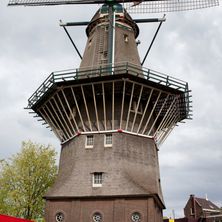

The current De Gooyer windmill was built in 18th century as a corn mill, however its history dates as far back as the 16th century. It had already existed at the outbreak of the 80-year war with the Spanish, and was destroyed by Admiral Lumey in 1572, along with many other windmills that had stood in this location, outside the city wall surrounding medieval Amsterdam. About 20 years later, the windmill was rebuilt by the son of the former owner and later its parts were sold to two the brothers: Claes and Jan Willemsz, who had originally come from the province of Gooiland. This explains the origin of the windmills name.
Due to the Amsterdam expansion in 1613, and then again in 1662, the mill was moved twice. Around 1725 it was rebuilt as we see it now, in an octagonal form with attached sails. The interior hull of the construction is built almost entirely of pine wood. It was later fortified by being placed on a stone house, which came from two demolished watermills that had once stood nearby and delivered fresh water to the city. The latter watermills were moved further out as the city expanded. As a corn and flour mill, De Gooyer was still in use early in the 20th century. However, as the sails had been in a rather dilapidated state, the production had to stop and, in 1928, the municipality purchased the mill from the milling company for 3200 guilders. After restoration was completed in 1929-30, the mill resumed its function and, during power supply shortages in World War II, worked as a corn mill. As a result of heavy storms in 1972, the sails were flapped about by the wind until the axis broke, the blades snapped off and ended up in the adjacent Nieuwvaart canal. Since such axes hadnt been made in decades, it took four years until the shaft was manufactured again specifically for De Gooyer. Restored anew in 1976, the mill also received original, old-Holland style sails, which are fully functional, although it is quite rare to see the windmill actually spinning. At 26,6 meters, De Gooyer is the tallest of the few remaining windmills in and around Amsterdam and happens to be the tallest wooden mill in the country. It is, unfortunately, closed to the public and cannot be visisted.
Adjacent to the windmill, under its auspices, as it were, the former municipal bathhouse dating from 1911 houses the Brouwerij at IJ brewery, a popular hangout for both the locals and the city visitors. Although it seems as if the mill and the brewery form one whole (the assumption strengthened by the fact the logo on the beer bottles features the famous windmill), these are, in fact, two different entities that arent connected to one another. Brouwerij 'at IJ is best known for its eco-beers. Set up by Kaspar Peterson in a squat in 1983, two years later it quickly grew and moved to the former bathhouse next to the mill. The microbrewers produce over three hundred thousand liters of the trendy and popular among Amsterdammers beer annually. Tours of the brewery can be scheduled by phone and beers can be tasted at the bar. Traditional types are called Plzen and Ijwit, while the heavier ones carry such names as Ostrich and Columbus.